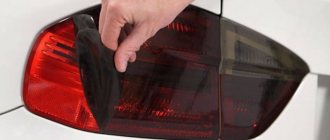Tuning and auto gadgets / From Vladimir
- Standards for tinting lighting fixtures: can it be done and how?
- What material to choose for proper tinting
- Necessary tools for DIY work
- How to tint headlights with film or varnish
How to tint the rear ones red: the fastest way on video
- How to make stickers on the front (video)
- Finished works in the photo (options for Chevrolet Cruze, VAZ and others)
Tinting your headlights is one of the ways to make your car stylish and unique. The possibility of auto tuning through tinting is widespread due to its accessibility, since modifying headlights does not require large financial and time expenditures. When planning to tint your optics, it is important to take into account many nuances so that you can avoid problems when the vehicle is stopped by traffic police officers.
Legend three: the fine for tinting lights is small
In the global judicial system, punishment largely depends on the interpretation of the crime. The same situation is with tinting. Neither the Code of Administrative Offenses, nor the “List of Malfunctions,” nor the “Basic Provisions on the Admission of Vehicles” says anything about it. But there are general words about lighting technology, and a lot.
Article 12.5 of the Code of Administrative Offenses only mentions the lighting equipment of the front part of the car, but not the rear part. In fact, this does not prevent the tinting of the rear lights from being regarded as non-compliance or a malfunction for which operation is prohibited. The same attitude will apply to foreign illumination of registration plates - white lighting is prescribed for the license plates. Partial tinting of the optics - the very edge along the contour - also does not work as legal.
One of the domestic companies willingly demonstrates its capabilities, while assuring that “light transmission does NOT change.” Note that the color of the rear lighting equipment prescribed by the standards is more or less preserved.
One of the domestic companies willingly demonstrates its capabilities, while assuring that “light transmission does NOT change.” Note that the color of the rear lighting equipment prescribed by the standards is more or less preserved.
Further, depending on the interpretation of the violation, several options are possible. From 500 rubles (the wording is “inappropriate type of vehicle”, the same as in relation to dirty headlights) to deprivation of rights for 6–12 months with confiscation of devices (the wording is “lighting devices, the color of the lights and the mode of operation of which do not meet the requirements "). They confiscate, however, not immediately, but by court decision. 500 rubles - a lot or a little? It's different for everyone.
Why do you need tint?
Typically, headlight tinting with film is done to improve the aesthetic characteristics of a car. Changing the color of the lighting fixtures allows the car to stand out among other cars and emphasize the originality of the exterior.
In addition, the tint film for headlights performs protective functions. It can protect the surface of lighting fixtures from the following damage:
- scratches;
- chips;
- microcracks;
- cloudiness.
Under the influence of ultraviolet rays and after exposure to small pebbles, sand, dust and dirt, glass loses its light transmittance over time, and the film helps maintain its condition.
Film for tinting headlights is available in a wide range on the market. It may differ in the following characteristics:
- color;
- thick;
- transparency.
Important! The wrong choice of material can cause an emergency on the road. Options with dark colors and low light transmission are especially dangerous.
Legend four: armoring headlights with film is not tinting!
Protecting your headlights from chips and scratches is a common sense idea. However, laws prohibit, firstly, interference in the design of vehicles (installation of equipment items that are not intended for the design, affecting safety), and secondly, the use of any uncertified equipment and materials. Formally, the inspector (if he wants) has the right to find fault with even a completely transparent film, since the parameters of its light transmission are unknown to him.
It is extremely doubtful that painting vinyl films in any way changes the characteristics of the luminous flux. But then it turns out that installing such films is illegal?
It is extremely doubtful that painting vinyl films in any way changes the characteristics of the luminous flux. But then it turns out that installing such films is illegal?
Thus, we can only ask the masters of branded headlight armoring for a document confirming that the transparent vinyl or polyurethane film stuck to the headlights affects light transmission in an acceptable way and is certified in Russia (and not in China, which did not sign the Vienna Convention) specifically for these goals. Then make a copy of the document and take it with you.
Materials used
To tint the lights on a vehicle, you can use varnishes or special films.
Car owners who want to carry out such visual modifications to the optics are thinking about which materials are better. You can immediately note that tinting headlights with varnish has more disadvantages compared to films. But the motorist himself will decide what exactly to cover the lighting devices with.
The driver should decide which option is best for him, since some tint the headlights with film, while others modify the optics with varnish.
When tinting the front and rear optics of a car, varnishes and vinyl films are used. The films are available in different colors, which allows you to play in contrast with the body color, or to tint the headlights strictly to match the color of the car. The film has obvious advantages over varnishes, since it is easy to remove and change if necessary; dismantling takes only a few minutes.
Vinyl films come in not only different colors, but also different densities and light transmittance. It is important to remember that films should only give a slightly different appearance to the car, and not block the glow emanating from the headlights. Otherwise, visibility on the roads will deteriorate significantly.
The legislation does not have clear requirements regarding the installation of films, their type or location of application. There is only a law requiring the mandatory use of only orange, yellow and white colors in headlights. All other colors are prohibited. Rear lights can be red, yellow and orange. Other colors are strictly prohibited. You can add that the license plate light and the reversing light should always be left white.
If you do not violate these rules and tint only within the permitted color range, you will not have any problems with the traffic police officers.
When choosing between varnish and film, it is definitely better to choose the option with vinyl films. Although they are more difficult to apply, there are no problems with removal. To remove the varnish, sometimes you have to completely replace the entire headlight. And these are completely different financial costs.
Legend five: tinting lighting equipment is beautiful and original
Beauty, by definition, is a subjective thing - what one likes may disgust others. Therefore, there is no point in arguing here. As for “originality,” a quick glance at the forums where headlight tinting topics are discussed is enough. Originality of this kind is assessed by the overwhelming majority of car owners (in a milder form) as stupidity.
Owning a car that is somewhat different from others may be pleasant in its own way. But does anyone at least check whether this thing shines enough at night? I doubt.
Owning a car that is somewhat different from others may be pleasant in its own way. But does anyone at least check whether this thing shines enough at night? I doubt.
Advantages and disadvantages
If you are thinking about whether you should tint your headlights or not, you need to focus your attention on the strengths and weaknesses of such tuning.
The advantages include the following:
- films protect the optics from minor damage;
- the film prevents intentional damage to the headlights;
- additional protection against chips and scratches;
- small shockproof effect;
- a way to keep headlights in their original form;
- good light distribution;
- light transmittance at 90-96%;
- vehicle decoration;
- Long lasting and more durable protection than polishing.
In theory, varnish has similar advantages. But it has too many significant shortcomings.
The main negative aspects of varnish as a material for tinting car optics are:
- low light transmittance. This material greatly blocks the light coming from the car's lighting fixtures. This has a negative impact on safety;
- irreversibility. Applying the polish is really easy. This does not require much time and effort. But once applied, it is almost impossible to get rid of the varnish. When it is removed from the surface, the optics body will most likely be damaged;
- life time. Immediately after application, the varnish looks impressive and beautiful. But this only lasts for a short time. This type of tinting is considered extremely short-lived;
- application. Although it is easy to treat the surface of a machine's optics, only a specialist with good experience in such work can apply varnish in a truly high-quality manner.
As for the disadvantages of vinyl film, it is worth noting the complexity of the application procedure, as well as the fairly high cost.
If you carefully study the instructions and practice a little, mastering the technique of applying film to optics will not be difficult. In terms of cost, each motorist decides for himself whether he is ready to pay that kind of money for tinting, or whether it is better to spend it on other ways to improve his car.
DIY gluing process
It is necessary to do tinting in a bright and warm room, and it is better with an assistant. It is unacceptable to work outdoors, where the wind blows dust that instantly settles on wet surfaces. To successfully tint the headlights, you need to prepare the following tools and auxiliary materials:
- a special plastic spatula with a rubber end called a squeegee;
- water tank with hand sprayer;
- construction hair dryer;
- scissors, a thin sharp knife (a stationery knife will do);
- tape measure and marker;
- soft rags or paper napkins;
- alcohol-based glass cleaner.
Set of tools for gluing film
Advice. If you don’t have a hair dryer, use a household hair dryer. To once tint the optics, it is quite enough.
To begin, measure the headlight lengthwise and crosswise with a tape measure to make a rough pattern. When cutting the material, allow a margin of 2 cm on each side. The further order of operations is as follows:
- Wash the headlights thoroughly with glass cleaner and dry them without touching them with your hands. While drying, cut out a piece of polymer to the required size.
- Remove the bottom protective layer from the film and moisten its surface with water using a sprayer. Also spray water on the headlight.
- Apply the tint to the optics so that the reserve is evenly distributed along the edges.
- Using a squeegee, gradually remove all the water from under the film, starting from the center and moving towards the edges. Avoid folds and distortions; work especially carefully on the outer zones.
- In places where the surface bends, where folds form, heat the material with a hairdryer and stretch it out a little.
- After making sure that the film fits tightly to the headlight in all places, trim off the excess with a knife, then go over the edges with a squeegee again.
- Carefully peel off the top protective layer and remove it from the tint. This completes the work.
It is better to tint long headlights together with an assistant
Advice. When using a spatula, do not be afraid to somehow damage the tint and press safely (within reason). The top layer serves precisely to protect the main film during the gluing process.
On a complex surface, the film must be heated with a hairdryer and stretched.
After tinting the lighting fixtures, check how well the film adheres to the corners. If in some places it extends beyond the scope of the optics, then such excess needs to be trimmed off. Then you can start gluing the rear lights, which is done using the same technology.
The procedure for gluing the film in the photo
When measuring the headlight for a pattern, add a margin of 2 cm on each side. Based on the measurements, sheets of material are cut out. The headlight must be thoroughly washed and sprayed with water. For gluing, you need to separate the protective layer. The film also needs to be moistened. Apply the film with an even margin on all sides. The polymer sticks when you run water from under it with a spatula. In difficult places, the material must be tightened, heating it with a hairdryer. After gluing, the remaining film is cut off. The cut part is carefully removed. At the end, do not forget to remove the top protective layer from the film.
Video about tinting using color films
Film
Almost everyone is familiar with this technology. The film is very often used when tinting glass. The method has many more advantages than varnish. Removing film, unlike varnish, is much easier, and it can be done at any time. The headlight tinting film has the function of protection against scratches and clouding. The texture of the material is uniform, the surface is perfectly smooth. The light transmittance of the film is much higher than that of varnish. The headlight receives a perfectly smooth surface, and it can be additionally polished - there will be no harm to the glass.
But it won't be without its downsides. Film for tinting headlights is more expensive than varnish. In addition, the appearance of the film is not as impressive. It is more difficult to apply than varnish from an aerosol can. But in all other respects, this option is a worthy choice for independent tuning.
Headlight tinting: is it possible to pass a technical inspection?
Theoretically, you can pass a technical inspection with tinted headlights. The same Code of Administrative Offenses does not in any way prohibit driving a vehicle where the headlights have a slightly reduced light transmittance. There is a clear ban on tinting the side and windshield, but nothing is said about the headlights. Conclusion of our motorists: not prohibited, therefore allowed.
But no. If you look at the requirements that a car must meet before being allowed to drive, it says: you cannot operate a vehicle where the headlights have a poor lighting function. Therefore, no service station employee should give the go-ahead when the headlights are tinted. And if you can still “close your eyes” when covering the rear lights, then when tinting the headlights this is strictly prohibited.
Which is better: film, varnish or paint?
As we said earlier, tinting can be done in three ways. Let's figure out which one is preferable, assessing all the pros and cons.
Let's start with tinting with varnish. It is sold in special cans. This method has a number of advantages:
- cheapness;
- beauty.
However, when talking about how exactly to tint, one cannot fail to mention the disadvantages. Among them:
- the need to remove the headlight to apply varnish;
- the impossibility of applying the product yourself due to the fact that few people succeed in doing it carefully;
- storage restrictions: the varnish is afraid of exposure to the sun (ultraviolet) and temperature changes;
- It is impossible to remove the layer, so you will have to change the entire optics.
Some experts argue that the varnish does not transmit light very well.
Another means is film. What are its main advantages? Among them:
- simple application and removal of the film, you can handle it yourself without damaging the optics;
- no need to remove headlights before application;
- in addition to changing the color of the headlights, the car owner receives glass protection from scratches, chips and other troubles that can be encountered on the road;
- many colors transmit light well.
The film has almost no shortcomings, we will only note these:
- before applying the film, it is better to practice on a cheap product of dubious quality;
- in general, the film is not too cheap.
You need to pay attention to ensure that the film is not excessively thick and dense. This will further absorb light.
Let's look at the last option for tinting paint. Just like varnish, it is sold in cans and is very similar to it in the way it coats the optics. The pros and cons of paint and varnish are the same.
As for the structure, if applied independently there will be not only streaks, but also unevenness in the layers. This will cause additional problems when passing the technical inspection. Acceptable colors for the front lights are orange, yellow and white, and for the rear lights - only white.
About Sun Control tint film
Sun Control films are produced by Garware Polyester Ltd, which is one of the five largest leaders in film production. Strict quality control, constant improvement of production technologies and a flexible pricing policy are the main priorities of the company's development. Sun Control films are famous for their low price and high quality, as well as a wide range of colors. There are films of different degrees of light transmission that block up to 98% of ultraviolet radiation, retain color and strength for 20 - 25 years. The protective layer makes it possible to avoid mechanical damage, and the adhesive layer helps to retain glass fragments if the window is damaged. Sun Control films are produced primarily in charcoal color and can have a mirror effect.
Headlight tinting: types of monetary penalties
You can tint the front or rear lights, or all at once. The color of the coating can be bright red or match the tone of the car. The headlights can simply be covered with a colorless film, protecting the surface of the device.
The following sanctions are provided:
- penalty for incorrect tinting of headlights - 3,000 rubles (more than 15% of light transmittance);
- penalty for tinting rear lights - 500 rubles.
And then we will consider the various options.











